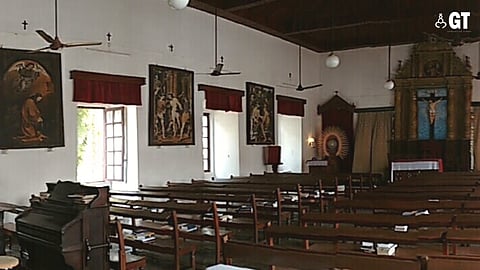

(Continued from 'Cool facts about this 400-year-old seminary in South Goa - Part I')
The church dedicated to St Ignatius of Loyola within the seminary has a magnificent gilt carved altar with the crucified Christ at the top centre, flanked by statues to the left, right and bottom. There are lateral panels inside the sanctuary that represent important scenes from the life of St Ignatius. The church’s ornate pulpit stands out in its gold leaf endowed resplendence.
One of the smaller altars to the left has the miraculous statue of the Infant Jesus of Colva that was found on a rock on the coast of Africa by a Jesuit priest called Fr Bento Ferreira. It was first kept at Colva and later moved to Rachol where it purportedly stopped working miracles.
The sacred bone relics and a vial marked with blood belonging to St Constancio, or Constance, (the mysterious soldier) were brought here by the Vincentians and are located in the small chapel to the left, inside the church, near the entrance. St Constancio, considered a martyr, was invoked by married women to protect them against widowhood.
His remains were exhumed from the cemetery at Ponciano and brought to Goa in 1782. The bones were laid out in the form of a body by Archbishop Fr Manoel de Santa Catharina and shown in a martial uniform to emphasise that the saint is a soldier of Christ. The FFF painted on the tomb stand for Fides, Fidelis, Fecit (The faith of the faithful has produced this). The saint is reported to have worked many miracles. Fervour for this devotion suffered, however, owing to a controversy related to the authenticity of the relics.
Next to the Chapel of the Good Shepherd on the first floor is the room that sheltered a famous resident, venerable Fr Agnelo de Souza, SFX, as he carried out the functions of a spiritual director from 1918 to 1927.
Swami Vivekananda is said to have visited the seminary and referred to some of the oldest books in its library. This famous library was blessed with the patronage of Archbishop Amorim Pessoa who contributed a collection of 7300 books, bought at the same time.
The seminary has grown structurally, with more modern additions being included over time to meet the needs of the students.
The array of paintings, mostly copies by SK Parab (1943-44), in the various corridors lend an air of piety that blends well with the peacefulness of the environment. One painting that holds your attention is the Disputation of the Holy Sacrament (La Disputa) by Raphael in the church's top corridor.
The Indianised Christian paintings of our own Angelo Da Fonseca have been copied and adorn the infirmary corridor. There are copies of other Renaissance masters such as Tiziano Vecellio, Albertinelli and Rubens.
It is unfortunate, however, that many of the paintings have been ruined altogether or partially destroyed. In 2017, the painting of Dom Sebastiao, King of Portugal, titled Armas del Rei D Sebastiao Fundador do Collegio, which denotes him as the founder of the college, was in much need of restoration.
The priestly formation takes a holistic approach by encouraging personal growth, participation in sports, music (The Choir of Santa Cecilia was established in 1897), gardening, farming, manual labour, etc. Spiritual formation and academic formation by way of courses in philosophy and theology are part of the process of seminarians being moulded into able priests. They are also sent out to pastoral visits to prisons, orphanages, broken homes, the sick and the elderly and so on.
The serenity of the Patriarchal Seminary of Rachol is only broken by the occasional footfall and voices of seminarians and priests. This integral part of our Goan heritage lives on as a beacon of divine hope, producing priests for the spiritual development of the Catholic laity.
Sources:
Torch-bearer of Catholicism in India (Goa Today, June 1969) by Nora Secco de Sousa from Goa Today Articles compiled by Maria Ana Paiva and Sneha S P Markarnekar
Goa: The Rachol Legacy by Teresa Albuquerque